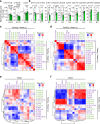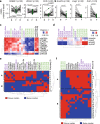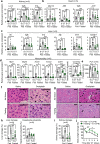Fatty acids homeostasis during fasting predicts protection from chemotherapy toxicity
- PMID: 36167809
- PMCID: PMC9515185
- DOI: 10.1038/s41467-022-33352-3
Fatty acids homeostasis during fasting predicts protection from chemotherapy toxicity
Abstract
Fasting exerts beneficial effects in mice and humans, including protection from chemotherapy toxicity. To explore the involved mechanisms, we collect blood from humans and mice before and after 36 or 24 hours of fasting, respectively, and measure lipid composition of erythrocyte membranes, circulating micro RNAs (miRNAs), and RNA expression at peripheral blood mononuclear cells (PBMCs). Fasting coordinately affects the proportion of polyunsaturated versus saturated and monounsaturated fatty acids at the erythrocyte membrane; and reduces the expression of insulin signaling-related genes in PBMCs. When fasted for 24 hours before and 24 hours after administration of oxaliplatin or doxorubicin, mice show a strong protection from toxicity in several tissues. Erythrocyte membrane lipids and PBMC gene expression define two separate groups of individuals that accurately predict a differential protection from chemotherapy toxicity, with important clinical implications. Our results reveal a mechanism of fasting associated with lipid homeostasis, and provide biomarkers of fasting to predict fasting-mediated protection from chemotherapy toxicity.
© 2022. The Author(s).
Conflict of interest statement
The authors declare no competing interests.
Figures







Similar articles
-
Coexisting role of fasting or feeding and dietary lipids in the control of gene expression of enzymes involved in the synthesis of saturated, monounsaturated and polyunsaturated fatty acids.Gene. 2012 Mar 15;496(1):28-36. doi: 10.1016/j.gene.2011.12.022. Epub 2011 Dec 23. Gene. 2012. PMID: 22248624
-
A lower proportion of dietary saturated/monounsaturated/polyunsaturated fatty acids reduces the expression of adiponectin in rats fed a high-fat diet.Nutr Res. 2012 Apr;32(4):285-91. doi: 10.1016/j.nutres.2011.12.016. Epub 2012 Apr 18. Nutr Res. 2012. PMID: 22575042
-
A combination of (ω-3) polyunsaturated fatty acids, polyphenols and L-carnitine reduces the plasma lipid levels and increases the expression of genes involved in fatty acid oxidation in human peripheral blood mononuclear cells and HepG2 cells.Ann Nutr Metab. 2011;58(2):133-40. doi: 10.1159/000327150. Epub 2011 Apr 29. Ann Nutr Metab. 2011. PMID: 21540583 Clinical Trial.
-
Dietary monounsaturated versus polyunsaturated fatty acids: which is really better for protection from coronary heart disease?Curr Opin Lipidol. 2003 Feb;14(1):41-6. doi: 10.1097/00041433-200302000-00008. Curr Opin Lipidol. 2003. PMID: 12544660 Review.
-
Dietary fat, insulin sensitivity and the metabolic syndrome.Clin Nutr. 2004 Aug;23(4):447-56. doi: 10.1016/j.clnu.2004.02.006. Clin Nutr. 2004. PMID: 15297079 Review.
Cited by
-
p21 is necessary for the beneficial effects of fasting during chemotherapy.Cancer Commun (Lond). 2023 Jan;43(1):164-168. doi: 10.1002/cac2.12384. Epub 2022 Nov 4. Cancer Commun (Lond). 2023. PMID: 36331275 Free PMC article. No abstract available.
-
Lipid Peroxidation via Regulating the Metabolism of Docosahexaenoic Acid and Arachidonic Acid in Autistic Behavioral Symptoms.Curr Issues Mol Biol. 2023 Nov 15;45(11):9149-9164. doi: 10.3390/cimb45110574. Curr Issues Mol Biol. 2023. PMID: 37998751 Free PMC article.
-
Short-term fasting and fasting mimicking diets combined with chemotherapy: a narrative review.Ther Adv Med Oncol. 2023 Mar 22;15:17588359231161418. doi: 10.1177/17588359231161418. eCollection 2023. Ther Adv Med Oncol. 2023. PMID: 36970110 Free PMC article. Review.
-
Fasting: A Complex, Double-Edged Blade in the Battle Against Doxorubicin-Induced Cardiotoxicity.Cardiovasc Toxicol. 2024 Dec;24(12):1395-1409. doi: 10.1007/s12012-024-09925-7. Epub 2024 Oct 1. Cardiovasc Toxicol. 2024. PMID: 39354217 Review.
-
Analysis of physiological and biochemical changes and metabolic shifts during 21-Day fasting hypometabolism.Sci Rep. 2024 Nov 18;14(1):28550. doi: 10.1038/s41598-024-80049-2. Sci Rep. 2024. PMID: 39557965 Free PMC article.
References
-
- Ruderman NB. Muscle amino acid metabolism and gluconeogenesis. Annu. Rev. Med. 1975;26:245–258. - PubMed
-
- Cahill GF, Owen OE, Morgan AP. The consumption of fuels during prolonged starvation. Adv. Enzym. Regul. 1968;6:143–150. - PubMed
-
- Nuttall FQ, Almokayyad RM, Gannon MC. Comparison of a carbohydrate-free diet vs. fasting on plasma glucose, insulin and glucagon in type 2 diabetes. Metabolism. 2015;64:253–262. - PubMed
-
- Merl V, et al. Serum adiponectin concentrations during a 72-hour fast in over- and normal-weight humans. Int. J. Obes. 2005;29:998–1001. - PubMed
Publication types
MeSH terms
Substances
LinkOut - more resources
Full Text Sources
Molecular Biology Databases

